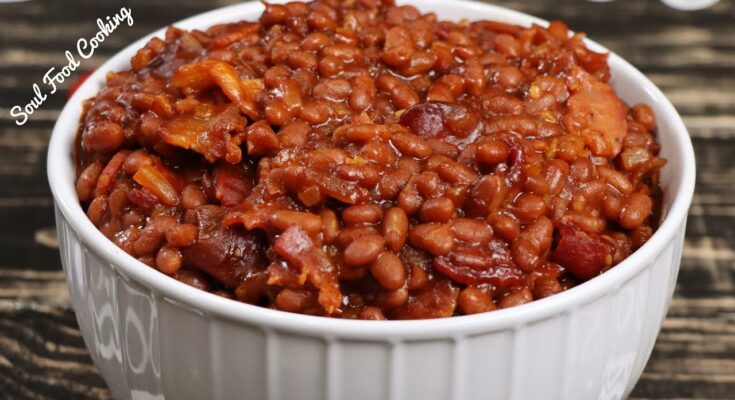Baked Bean Recipe: Baked beans are a classic comfort food beloved around the world. Whether served as a side dish at BBQs or enjoyed as a hearty meal on a cold day, they offer the perfect blend of sweet, savory, and smoky flavors. With their rich history and versatility, baked beans can be customized to suit any palate.
What Are Baked Beans?
Baked beans typically consist of navy beans (or other white beans) cooked slowly in a tomato-based or molasses-based sauce. Originating from Native American and British recipes, they have become a popular dish globally. Different cultures add their own twists with spices, meats, and sweeteners.
Why You’ll Love This Recipe
This recipe focuses on rich, balanced flavors while keeping the steps simple. You’ll get tender beans with a thick, flavorful sauce every time. Plus, it’s highly customizable—whether you prefer a vegetarian option or want to add smoky bacon, this guide has you covered.
Ingredients for Baked Beans
A great recipe starts with quality ingredients. Here’s what you’ll need:
Main Ingredients
- 2 cups dried navy beans or great northern beans
- 1 onion, finely chopped
- 3 cloves garlic, minced
- ½ cup molasses (or brown sugar for sweetness)
- 1 can (14 oz) crushed tomatoes
- 1 tablespoon mustard
- 1 tablespoon Worcestershire sauce
- 2 cups vegetable or chicken broth
Optional Add-Ins for Flavor
- 4-5 strips of bacon (for a smoky flavor)
- 1 tablespoon smoked paprika
- 1 diced jalapeño for heat
- Maple syrup for a sweet twist
Equipment Needed
Gathering the right tools makes the process much smoother.
Basic Kitchen Tools
- Large pot or Dutch oven
- Measuring cups and spoons
- Mixing spoon
Special Tools for the Perfect Recipe
- Pressure cooker (optional for quick cooking)
- Slow cooker (for hands-off cooking)
- Oven-safe dish (for finishing in the oven)
Preparing Your Beans
Proper preparation ensures that your beans cook evenly and absorb all the delicious flavors.
Soaking the Beans
Soaking beans helps to soften them and reduces cooking time.
Steps:
- Rinse the beans under cold water to remove debris.
- Place beans in a large bowl with enough water to cover them by 2 inches.
- Allow them to soak for at least 8 hours or overnight.
Quick vs. Overnight Soaking
If you’re in a rush, try the quick-soak method:
- Bring the beans and water to a boil, then remove from heat and let sit for 1 hour.
- Drain and rinse before proceeding with the recipe.
Cooking the Baked Beans
This step-by-step guide gives you different cooking options based on your preferences.
Cooking on the Stovetop
- Sauté onions and garlic in a large pot until softened.
- Add soaked beans, crushed tomatoes, molasses, mustard, Worcestershire sauce, and broth.
- Simmer on low heat for 2-3 hours, stirring occasionally, until beans are tender.
Baking in the Oven
- Preheat oven to 325°F (163°C).
- Transfer beans and sauce to an oven-safe dish.
- Cover and bake for 1.5 to 2 hours, checking occasionally to prevent drying.
Slow Cooker or Pressure Cooker Method
For a hands-off option, slow cook the beans on low for 6-8 hours. Alternatively, pressure cook for 40 minutes with natural release.
Enhancing the Flavor
Want to take your baked beans to the next level? Here are some flavor-enhancing ideas.
Adding Bacon or Sausage
Sauté diced bacon or sausage in the pot before adding onions and garlic. This adds depth and a smoky richness to the dish.
Vegetarian and Vegan Options
Replace Worcestershire sauce with a vegan alternative and skip the meat. You can also add smoked paprika for a plant-based smoky flavor.
Tips for Perfect Baked Beans
Making baked beans isn’t complicated, but a few tricks can make a big difference in texture and flavor.
How to Prevent Beans from Being Too Hard
Ever had beans that stayed tough no matter how long you cooked them? This happens when beans aren’t soaked properly or are too old. Here’s how to avoid it:
- Always use fresh, high-quality beans.
- Soak the beans for at least 8 hours to soften the outer skin.
- Avoid adding acidic ingredients (like tomatoes or vinegar) too early in the cooking process, as they can hinder softening.
Balancing Sweet and Savory Flavors
Great baked beans are all about balance. Too much molasses or sugar can make the dish overly sweet, while too many spices can overpower the natural flavor of the beans. Taste your dish as it cooks, and adjust seasonings gradually. A splash of apple cider vinegar can help cut through excess sweetness.
Common Mistakes to Avoid
Avoiding common pitfalls can ensure your baked beans turn out perfectly every time.
Overcooking or Undercooking Beans
- Overcooking: If you let your beans simmer for too long, they may become mushy. Monitor their texture and reduce the heat if needed.
- Undercooking: Beans that haven’t cooked long enough will be tough. Ensure you simmer the beans long enough for them to be tender but not falling apart.
Not Using Enough Liquid
Beans absorb a lot of liquid during cooking. If there isn’t enough liquid, they’ll dry out and the sauce will thicken too quickly. Always check the liquid level and add more broth or water as needed.
Serving Suggestions
Baked beans are a versatile dish that pairs well with various foods and fits perfectly on any table.
Popular Side Dishes to Pair With Baked Beans
- BBQ meats: Pulled pork, grilled chicken, and ribs are classic pairings.
- Cornbread: The sweetness of cornbread complements the smoky and savory flavors of baked beans.
- Coleslaw: A cool, crunchy coleslaw offers a refreshing contrast.
Best Occasions for Serving
Baked beans are perfect for:
- Summer BBQs and picnics
- Potlucks and family gatherings
- Hearty winter meals alongside roasted meats
Storing and Reheating Baked Beans
Proper storage and reheating methods help preserve the flavor and texture of your beans.
Proper Storage Techniques
- Let the beans cool to room temperature.
- Store them in an airtight container.
- Refrigerate for up to 5 days.
For longer storage, you can freeze baked beans. Use a freezer-safe container, leaving a bit of space at the top to allow for expansion.
Best Methods to Reheat Without Losing Flavor
- Stovetop: Reheat the beans over low heat, stirring occasionally, and add a splash of water or broth if the sauce is too thick.
- Microwave: Heat in a microwave-safe dish, covered, to retain moisture. Stir halfway through reheating to ensure even heat distribution.
- Oven: For large batches, reheat at 325°F (163°C) for 20-30 minutes.
Nutritional Information
Baked beans can be both delicious and nutritious, especially if you control the ingredients.
Health Benefits of Baked Beans
- Rich in fiber: Beans are an excellent source of dietary fiber, promoting healthy digestion.
- High in plant-based protein: Great for vegetarians and those looking to reduce meat consumption.
- Packed with vitamins and minerals: Beans provide important nutrients like iron, potassium, and magnesium.
Tips for Healthier Modifications
- Reduce the amount of sugar or molasses in the recipe.
- Use low-sodium broth and reduce added salt.
- Skip the bacon and add extra vegetables for a healthier, plant-based dish.
Customizing Your Recipe
There’s no one-size-fits-all when it comes to baked beans. Experiment to create your perfect version.
Regional Variations of Baked Beans
Different regions have their own take on baked beans:
- New England: Often made with molasses and brown sugar for a sweet flavor.
- Southern-style: Incorporates bacon or ham hocks and sometimes a bit of spice.
- British-style: Tomato-based with a slightly tangy flavor, often served on toast.
Experimenting with Different Spices
- Try adding cumin or chili powder for a southwestern twist.
- Add a hint of cinnamon or nutmeg for warmth.
- Fresh herbs like thyme or rosemary can add a subtle, earthy flavor.
FAQs about Baked Bean Recipe
1. Can I use canned beans instead of dried beans?
Yes! Canned beans save time and are convenient. Simply rinse and drain them before use to reduce excess salt and improve flavor absorption.
2. How do I thicken the baked beans?
To thicken baked beans, simmer them uncovered for a longer period. You can also mash a small portion of the beans to release starch and naturally thicken the sauce.
3. What can I add to enhance the flavor?
You can enhance the flavor by adding ingredients like smoked bacon, barbecue sauce, molasses, mustard, or a splash of apple cider vinegar for a tangy twist.
4. Are baked beans gluten-free?
While beans are naturally gluten-free, some sauces and seasonings may contain gluten. Check ingredient labels or use certified gluten-free sauces if needed.
5. How do I store and reheat leftover baked beans?
Store baked beans in an airtight container in the refrigerator for up to 4 days. Reheat them on the stove or in the microwave, adding a splash of water if needed to loosen the sauce.
6. Can I freeze baked beans?
Yes, baked beans can be frozen for up to 3 months. Allow them to cool completely, then transfer them to a freezer-safe container. Thaw overnight in the fridge before reheating.
Conclusion
Baked beans are a timeless dish that can be customized to suit any occasion or preference. Whether you prefer them sweet and smoky or rich and savory, this recipe provides a reliable framework for delicious results every time. With proper preparation and a few expert tips, you’ll have a dish that impresses at BBQs, family dinners, or solo comfort food nights. Give it a try—you won’t be disappointed!



